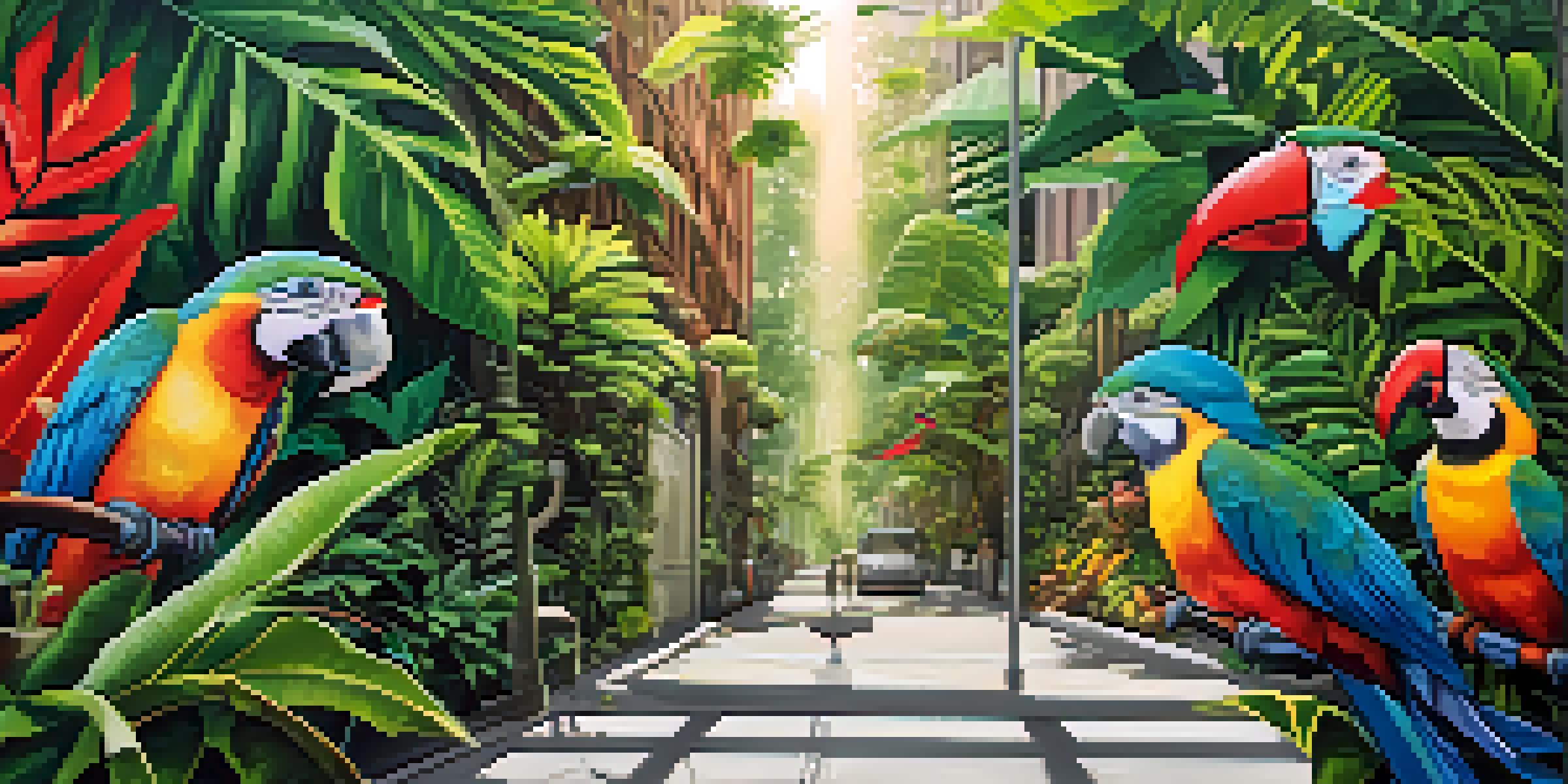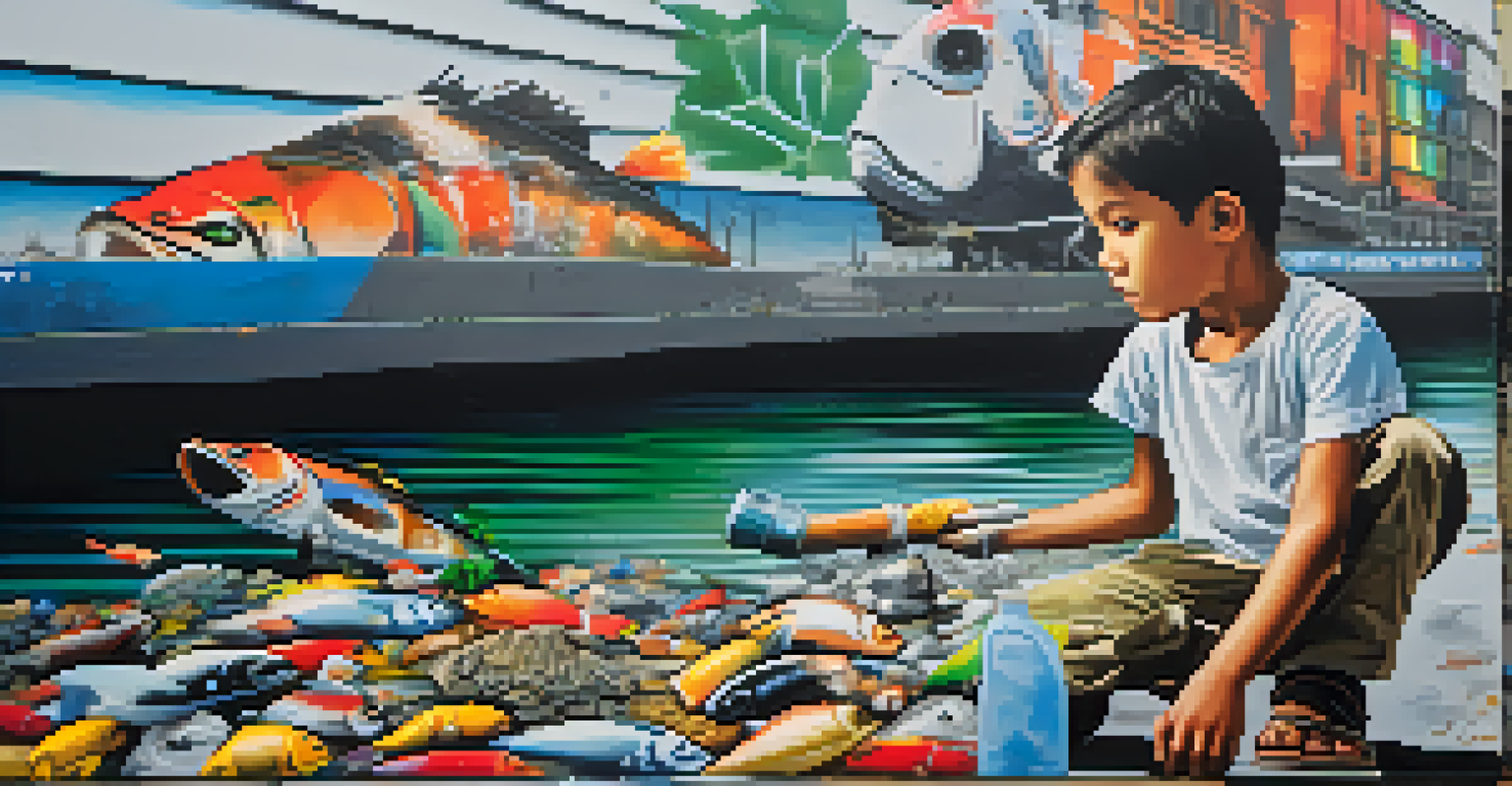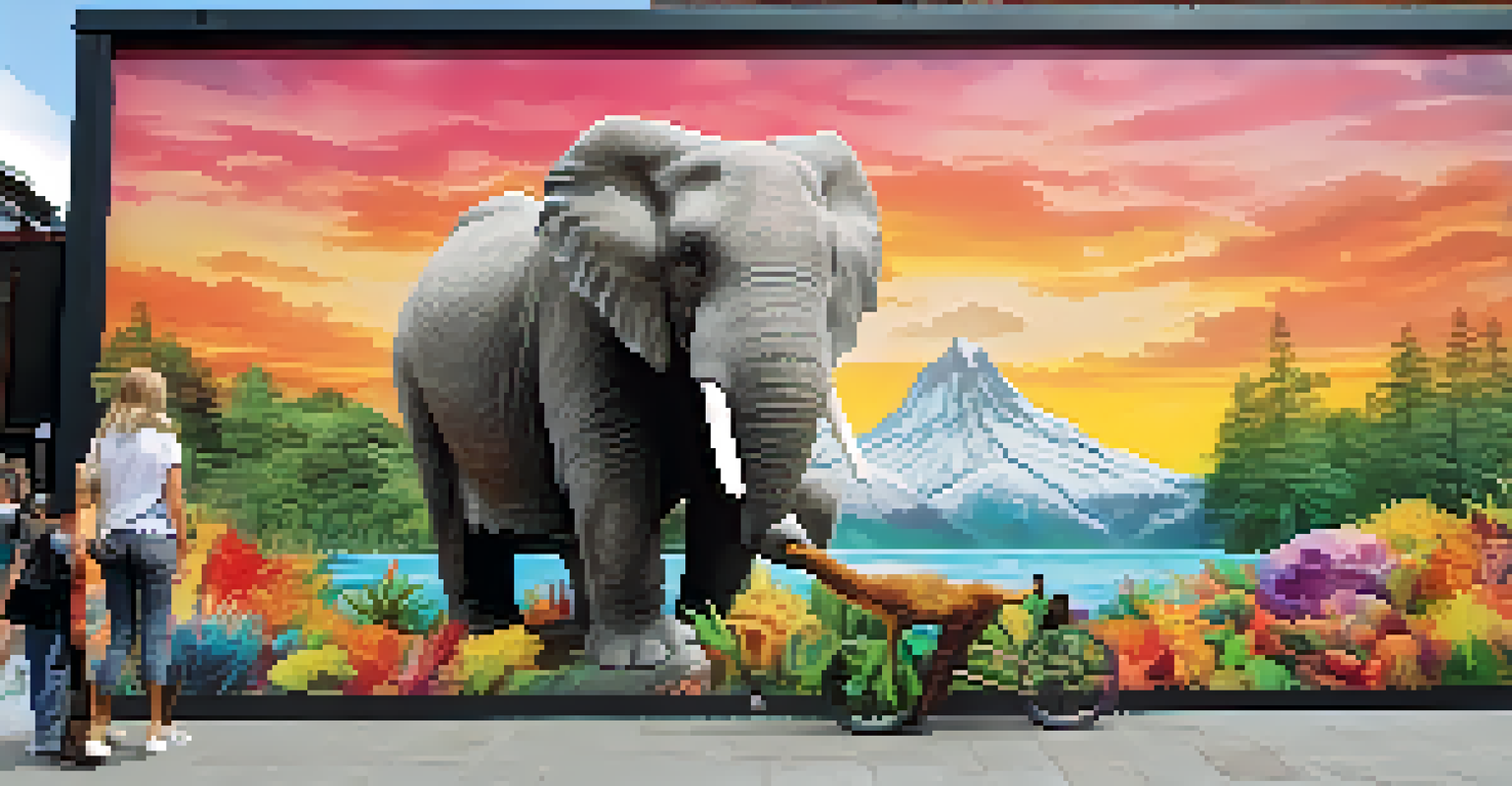Environmental Messages in Street Art: A Green Revolution

Street Art as a Voice for the Environment
Street art has emerged as a powerful platform for environmental advocacy, allowing artists to express their concerns about climate change and pollution. These vivid murals and graffiti pieces not only beautify urban spaces but also provoke thought and discussion about pressing ecological issues. By transforming walls into canvases, artists can reach a broad audience, often sparking conversations that might not happen otherwise.
Art is not a mirror to hold up to society, but a hammer with which to shape it.
For instance, in cities like Berlin and Melbourne, artists use their work to highlight local environmental challenges, such as waste management and deforestation. These artworks serve as visual reminders of the urgent need for sustainability and conservation efforts. When passersby encounter these striking visuals, they are often compelled to reflect on their own environmental impact.
Moreover, the anonymity of street art allows for a raw and honest portrayal of environmental issues, unfiltered by commercial interests. This authenticity resonates with viewers, making them more likely to engage with the message. In this way, street art becomes not just an aesthetic choice but a revolutionary call to action for a greener planet.
Cultural Reflections in Urban Environments
Street art often reflects the cultural identity of a community, and when environmental themes are woven into this fabric, it can create a powerful narrative. Artists draw from local histories, traditions, and landscapes to craft messages that resonate deeply with residents. This cultural connection not only enhances the relevance of the environmental message but also fosters a sense of ownership and responsibility within the community.

For example, in Brazil, artists have created murals that celebrate the Amazon rainforest while simultaneously raising awareness about deforestation. These artworks not only honor the beauty of the landscape but also call for its protection, appealing to both local pride and global consciousness. Such pieces remind viewers that safeguarding the environment is a shared responsibility.
Street Art Sparks Environmental Dialogue
Street art serves as a powerful platform for raising awareness about environmental issues, engaging communities, and prompting discussions on sustainability.
As these cultural expressions proliferate, they help to cultivate a collective identity around environmental stewardship. When art embodies the spirit and values of a community, it becomes a rallying point for collective action and change. This cultural dialogue can inspire individuals to adopt more sustainable practices in their daily lives, reinforcing the message that every small action counts.
The Role of Social Media in Amplifying Messages
In today's digital age, social media plays a crucial role in amplifying the reach and impact of street art. Artists often share their work on platforms like Instagram and Twitter, allowing their environmental messages to spread far beyond their local communities. This online visibility not only attracts attention to specific issues but also connects artists with audiences who are passionate about sustainability.
The greatest threat to our planet is the belief that someone else will save it.
For instance, the viral nature of social media can turn a single mural into a global phenomenon, sparking conversations that can lead to real-world action. Hashtags related to environmental street art can unify voices across the globe, creating a digital community of advocates. The potential for collaboration and solidarity is immense, as artists and activists come together to promote green initiatives.
Moreover, social media provides a platform for dialogue, enabling viewers to engage with the artwork and the ideas it represents. Comments, shares, and discussions can lead to increased awareness and education about environmental issues. This interactive aspect fosters a sense of community and encourages individuals to take part in local environmental efforts, ultimately contributing to a larger movement for change.
Street Art and Community Engagement
One of the most exciting aspects of street art is its ability to foster community engagement around environmental issues. Many artists collaborate with local organizations and residents to create works that reflect the community's values and concerns. This partnership not only enriches the artwork but also empowers individuals to take ownership of their environment.
Initiatives like community mural projects invite residents to contribute their ideas and input, creating a sense of collective purpose. For example, in Philadelphia, local artists worked with residents to create a mural that addresses the impact of climate change on their neighborhood. This collaboration not only beautified the area but also ignited discussions about sustainability and resilience.
Cultural Identity and Environmental Art
Integrating local culture into street art fosters a sense of community ownership and responsibility towards environmental stewardship.
Through this collaborative process, street art becomes a tool for education and awareness, helping communities envision a more sustainable future. By actively involving residents in the creation of environmental art, artists spark a deeper connection to the message. This grassroots approach can lead to lasting change, as communities unite to protect their shared spaces.
Highlighting Environmental Injustice
Street art often serves as a commentary on environmental injustice, drawing attention to the disproportionate impact of ecological issues on marginalized communities. Artists use their platforms to voice the struggles faced by these communities, creating powerful visual narratives that demand action and change. This focus on social equity highlights the intersection of environmental and social justice.
For example, in cities like Los Angeles, murals depict the realities of air pollution and toxic waste in low-income neighborhoods, raising awareness of how these issues are often overlooked. By shining a light on these injustices, street artists challenge viewers to confront uncomfortable truths and advocate for policy changes. These artworks can serve as catalysts for community organizing and activism.
Furthermore, by amplifying the voices of those most affected, street art contributes to a more inclusive dialogue about environmental solutions. It underscores the need for equitable policies that address the root causes of environmental degradation. In this way, street art becomes a powerful tool for both raising awareness and inspiring action towards a more just and sustainable future.
Inspiring Future Generations Through Art
Street art has the potential to inspire younger generations to engage with environmental issues creatively. By making complex topics accessible and visually appealing, artists can capture the imagination of youth, encouraging them to think critically about their role in the ecosystem. This inspiration can lead to a new wave of environmental advocates who use art as a means of expression and activism.
For instance, workshops that teach young people how to create their own street art can empower them to voice their concerns about the environment. These experiences not only foster artistic skills but also instill a sense of responsibility towards their communities and the planet. When youth see their ideas represented in public art, it validates their voices and encourages them to take action.
Social Media Amplifies Environmental Art
Social media enhances the reach of street art, connecting artists and audiences globally to inspire action and awareness around ecological challenges.
Additionally, street art can serve as a bridge between generations as older artists mentor younger ones, sharing knowledge and experiences. This mentorship fosters a culture of collaboration and shared purpose, where the commitment to environmental advocacy is passed down. As these young artists grow, they carry with them the lessons learned from their mentors, continuing the cycle of art-driven environmental activism.
The Future of Environmental Street Art
As the environmental crisis continues to escalate, the role of street art in advocacy is likely to grow even more significant. Artists will increasingly harness their creativity to address emerging ecological challenges, using their work to inspire action and promote sustainability. This evolution will likely lead to even more innovative and impactful pieces that captivate audiences and provoke thought.
Future trends may include the integration of technology, such as augmented reality, into street art, creating immersive experiences that engage viewers on multiple levels. Imagine walking past a mural that comes to life with animation, illustrating the effects of climate change in real-time. Such advancements could enhance the impact of environmental messages and reach broader audiences.

Ultimately, the future of environmental street art lies in its ability to adapt and respond to the changing landscape of ecological issues. As artists continue to push boundaries and explore new mediums, their work will remain a vital part of the global conversation about sustainability. Through this creative expression, street art will continue to challenge, inspire, and drive change in the quest for a greener future.